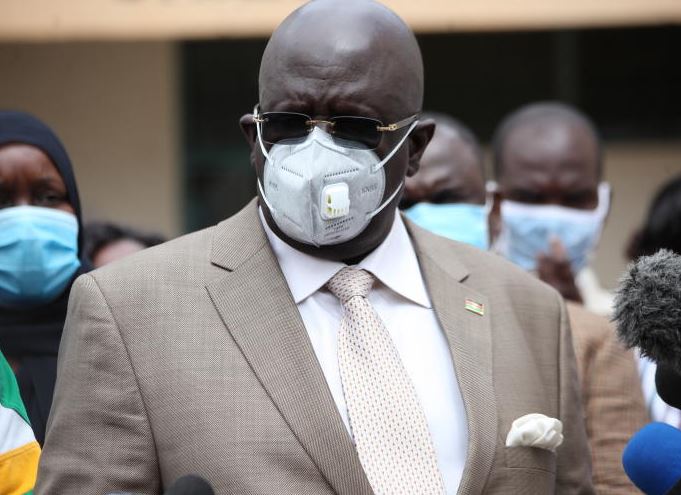
The education sector spent Sh768.5 billion on education in the last financial year, latest statistics by the Ministry of Education show.
The Basic Education Statistical Booklet 2019, released on Saturday by Education Cabinet Secretary George Magoha (pictured), shows that total expenditure on education rose from Sh625.6 billion in 2016/17 to Sh768.5 billion in the 2018/19 financial year, with the national government and households being the largest two funders.
The booklet is an outcome of the Fatuma Chege-led curriculum review task force that was formed by Magoha to gather data on education that will help roll out the Competency-Based Curriculum (CBC).
The new data shows that during the last financial year, 53 per cent and 33 per cent of spending in the education sector were from the national government and households, respectively. Household expenditure consists of fees and other indirect expenses borne by parents towards meeting costs of education. Internally generated revenue and county governments are other important sources of funding for the sector.
“Over the years, my ministry has put in place structures and systems to ensure collection, storage, retrieval and use of credible, reliable and accurate data. The establishment and operationalisation of the National Education Management Information System (NEMIS) has enabled the collection of real time data on various key indicators crucial to the ministry, education stakeholders and development partners in management and financing of education in Kenya,” Magoha said.
Availability of credible empirical data, he said, is therefore crucial as the government continues to implement reforms at all levels of education and training.
“More importantly, this booklet provides key data to guide in policy direction as the government continues with the implementation of the CBC. For instance, it provides key baseline information on the current status of the education indicators in preparation for implementation of the pathways in CBC,” Magoha said.
The data shows that by the end of last year, the country had 46,530 pre-primary centres, 32,344 primary schools and 10,487 secondary schools.
The number of pre-primary centres increased from 41,779 in 2017 to 46,530 in 2019, representing a growth of 11.4 per cent. The public sector witnessed a higher increase in the number of centres by about 11.8 per cent, from 25,381 in 2017 to 28,383 in 2019. This was partly due to accelerated investment in new pre-primary centres by county governments following the devolution of pre-primary education function.
Private sector
Similarly, the private sector witnessed a 10.7 per cent increase in the number of pre-primary centres, from 16,398 in 2017 to 18,147 in 2019.
However, the share of private pre-primary centres remained at about 40 per cent. Primary schools increased from 31,449 in 2017 to 32,344 in 2019, representing an increase of 2.8 per cent. Public primary schools increased by 0.6 per cent, from 23,139 schools in 2017 to 23,286 in 2019 while private primary schools increased by nine per cent, from 8,310 schools in 2017 to 9,058 in 2019.
The report shows there was a higher rate of increase in the number of private primary schools relative to public schools, though public primary schools still account for the largest share of primary schools, at 72 per cent.
At secondary school level, the number of schools increased by 16.8 per cent, from 8,958 in 2017 to 10,487 in 2019. The number of public secondary schools increased by 18.4 per cent, from 7,543 in 2017 to 8,933 in 2019 while private secondary schools increased by 9.7 per cent, from 1,415 in 2017 to 1,554 in 2019.
Stay informed. Subscribe to our newsletter
Unlike the case in primary schools, there was a higher percentage increase in public secondary schools relative to private schools.
The report shows that over the three-year period, public secondary schools have accounted for about 85 per cent of all secondary schools in Kenya, partly due to the Free Day Secondary Education (FDSE) and the 100 per cent transition policy.
It further says 18,700 public primary schools have valid Global Positioning System (GPS) codes, generated from the technology-enabled teacher support under the Tusome literacy programme and Early Grade Mathematics programme under the Primary Education Development (PRIEDE) project.
The distribution of schools is correlated to the average school-size and mirrors human settlement patterns and population distribution. “The GPS data is also critical in mapping the learning institutions, major infrastructure like roads, amenities and key installations like electricity, internet and other communication infrastructure,” Magoha said.
The report also says that by end of last year, there were 2,738,587 children enrolled in pre-primary centres, 10,072,040 in primary schools and 3,262,951 in secondary schools.
There were 30 per cent, 16 per cent and seven per cent of the learners enrolled in the pre-primary, primary and secondary levels, respectively, in private schools.
According to the data, there are slightly more boys than girls enrolled from Grade 1 to Class 6. From Class 7 to Form 2, the converse is true. There are slightly more girls than boys enrolled.
In Form 3, the number of boys is almost equal to the number of girls whereas in Form 4, the number of boys exceeds the number of girls.
At pre-primary level, in pre-primary One (PP1), there was gender disparity in favour of boys, while in PP2 gender parity was achieved. At primary school level, from Grade 1 to Grade 4, there was gender disparity in favour of boys. From Class 5 to Class 7, the country achieved gender parity.
The data shows that in Class 8, there was gender disparity in favour of girls. At secondary school level, from Form 1 to 3, the country achieved gender parity while in Form 4, there was gender disparity in favour of boys.
The report shows that Special Needs Education (SNE) public primary institutions increased by two per cent, from 2,865 in 2017 to 2,927 in 2018 and further by six per cent, to 3,043 in 2019.
Special needs
Similarly, SNE public secondary institutions increased by 2.8 per cent, from 106 in 2017 to 109 in 2018 and further by 4.6 per cent, to 114 in 2019. Enrolment in public primary institutions increased by 26 per cent, from 108,221 learners in 2017 to 136,081 learners in 2019. Enrolment in public secondary institutions increased by 19 per cent, from 4,019 in 2017 to 4,794 in 2019. The report says the increase in institutions has been accompanied by an increase in the number of special needs learners.
The report further shows the retention rate at primary school level was considered at two levels, from Standard 1 to 6, which was 96.10 per cent and from Standard 1 to 8, which stood at 81.90 per cent.
The retention rate for Standard 1 to Standard 6 indicates that about 4 per cent of this cohort dropped out of school or repeated classes preceding Standard 6. In relation to Standard 1 to Standard 8 retention rate, 18.1 per cent of the learners who joined Standard 1 in 2012 did not reach Standard 8 as they either dropped out of school or repeated classes.
From the analysis, with six years of primary schooling, the retention rate is higher as compared to when the schooling goes for eight years. At secondary school level, the retention rate from Form 1 to 4 was 103.3 per cent.
The writer is a 2019/2020 Bertha Fellow
 The Standard Group Plc is a
multi-media organization with investments in media platforms spanning newspaper
print operations, television, radio broadcasting, digital and online services. The
Standard Group is recognized as a leading multi-media house in Kenya with a key
influence in matters of national and international interest.
The Standard Group Plc is a
multi-media organization with investments in media platforms spanning newspaper
print operations, television, radio broadcasting, digital and online services. The
Standard Group is recognized as a leading multi-media house in Kenya with a key
influence in matters of national and international interest.
 The Standard Group Plc is a
multi-media organization with investments in media platforms spanning newspaper
print operations, television, radio broadcasting, digital and online services. The
Standard Group is recognized as a leading multi-media house in Kenya with a key
influence in matters of national and international interest.
The Standard Group Plc is a
multi-media organization with investments in media platforms spanning newspaper
print operations, television, radio broadcasting, digital and online services. The
Standard Group is recognized as a leading multi-media house in Kenya with a key
influence in matters of national and international interest.






